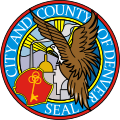Current usage
The park includes concrete trails often filled with walkers, runners, and bikers. Some grassy areas, river overlooks, and park benches are also available. Two pedestrian bridges cross the South Platte River and Cherry Creek at Confluence Park. The eastern edge of the South Platte in Confluence Park has been transformed into a kayak run, immediately across from R.E.I.'s (Recreational Equipment Inc.) Colorado flagship store. The park is adjacent to a number of new up-scale townhouses, apartments, and loft developments, another park bordering the South Platte downstream, train tracks, and Denver's skatepark.
The Platte Valley Trolley originates in Confluence Park, running along the west side of the South Platte River from Memorial Day weekend through Labor Day weekend, and for all Denver Broncos home games.
This page is based on this
Wikipedia article Text is available under the
CC BY-SA 4.0 license; additional terms may apply.
Images, videos and audio are available under their respective licenses.



